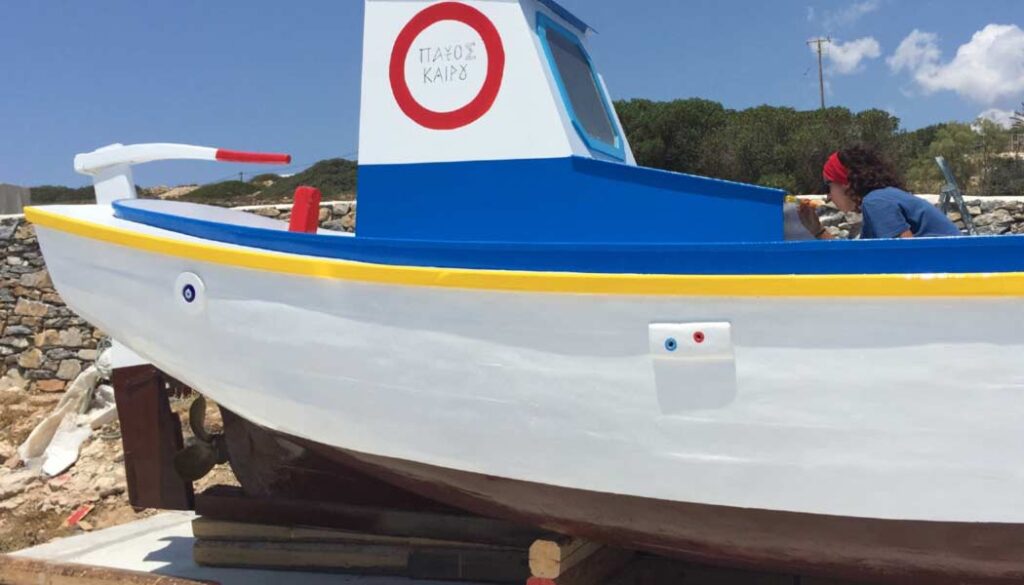
Can You Paint Over Gel Coat? [What to Know]
Yes, you can paint over gel coat. Before painting over gel coat, you should know about the fascinating world of gel coat and its versatility in the realm of painting. Gel coat is a durable and glossy material. People typically use this coat to protect the surfaces of fiberglass-reinforced composite materials.

However, with the desire for customization and artistic expression, the question arises: can you paint over gel coat? So, let’s dive into the process of painting over gel coat, the necessary steps, and potential considerations to elevate the appearance of gel coat surfaces.
Can You Paint Over Gel Coat?
Gel coat surfaces are often used in fiberglass-reinforced materials for its protective and glossy finish. Moreover, this coat can be customized with paint. To achieve a successful paint job, thorough surface preparation is crucial.
Cleaning, sanding, and using an appropriate primer are essential steps to ensure the paint adheres properly. Once prepped, you can unleash your creativity and add a personal touch with various paint types, colors, and designs. This will transform the gel coat surface to your desired look.
What Paint to Use Over Gel Coat?
When painting over gel coat, it’s essential to choose the right type of paint to ensure proper adhesion and a long-lasting finish. Let’s see some paint options you can consider to paint over gel coat.
- Marine-Grade Polyurethane Paint
Marine-grade polyurethane paint is a popular choice for painting over gel coat surfaces. It offers excellent durability, UV resistance, and superior protection against saltwater. It also makes it ideal for marine applications and outdoor use.
- Two-Part Epoxy Paint
Epoxy paints are known for their exceptional adhesion and chemical resistance. When applied correctly, they form a strong bond with the gel coat. Moreover, this paint provides a durable and long-lasting finish. Two-part epoxy paints require mixing a resin with a hardener before application.
- Acrylic Enamel Paint
Acrylic enamel paints are another option for painting over gel coat. They are easy to apply and dry to a hard, glossy finish. This paint may not be as durable as polyurethane or epoxy paints. However, they still offer good protection and are suitable for non-marine applications.
- Gel Coat-specific Paints
Some manufacturers produce paint specifically designed for painting over gel coat surfaces. These paints are formulated to adhere well to gel coat and provide a seamless finish.
How to Paint Over Gel Coat?
Painting over gel coat requires proper surface preparation and careful application. A careful application will help to achieve a smooth and durable finish. Here’s a step-by-step guide to help you through the process.
Step-1: Clean the Surface
Thoroughly clean the gel coat surface to remove any dirt, dust, grease, or wax. Use a mild detergent and water solution, and rinse it well. Allow the surface to dry fully before proceeding.
Step-2: Sand the Surface
Use fine-grit sandpaper (around 220-320 grit) to lightly sand the gel coat surface. The goal is to create a rough texture for better paint adhesion. Be gentle and avoid sanding too aggressively to prevent damaging the gel coat.
Step-3: Remove Sanding Residue
After sanding, wipe the surface with a clean and damp cloth to get rid of any sanding residue. Let it dry before moving on.
Step-4: Choose the Paint Type
Select the appropriate paint type based on your intended use and preferences. Marine-grade polyurethane paint, two-part epoxy paint, acrylic enamel paint, or gel coat-specific paint is common options.
Step-5: Apply Primer
Some paint types may require a primer for optimal adhesion. Check the paint manufacturer’s recommendations to determine if a primer is necessary. If needed, apply thin coats of primer and allow it to dry.
Step-6: Stir the Paint
If you’re using a two-part epoxy or gel coat-specific paint, thoroughly mix the components according to the instructions. Stir the paint well to ensure a consistent and homogenous mixture.
Step-7: Apply the Paint
Use a paintbrush or paint sprayer to put the paint over the gel coat surface. Start from one end and work your way systematically to ensure complete coverage. For best results, you should use multiple even layers than a single thick layer. Wait until every coat is properly dried before applying the new coat.
Step-8: Let the Paint Cure
Follow the paint manufacturer’s recommended curing time. This ensures the paint fully sets and provides a durable finish.
Can You Paint Directly Over Gelcoat?
Properly cleaning and sanding the gel coat surface is a must to ensure good paint adhesion. Once the gel coat is clean and lightly sanded to create a rough texture, you can apply the paint of your choice directly onto the gel coat.
However, some paint will require good adhesion. So, it’s essential to check the paint manufacturer’s guidelines to determine if a primer is necessary for the specific paint you’re using.
Can You Spray Paint Over Gel Coat?
Spray paint is one of the special types of paint. But you can apply it over gel coat. Before spray painting, you should clean the gel coat surface thoroughly. Then sanding the surface will make the texture rough and suitable for another paint.
However, spray painting provides a professional finish. Using a paint sprayer can be efficient and ideal for covering large gel coat surfaces or achieving a uniform coat. Ensure to choose paint well-suited with your sprayer. Properly ventilate the area and wear appropriate safety gear during the spray painting process.
How to Paint Over Gelcoat Fiberglass?
You can exert a gelcoat-specific paint designed explicitly for painting over gelcoat fiberglass surfaces. These paints are formulated to adhere well and provide a seamless finish. So, let’s see how to successfully paint over gelcoat fiberglass.
Step-1: Surface Preparation
Clean the gelcoat fiberglass thoroughly to eliminate any contaminants, dirt, or wax. Use a fiberglass cleaner or acetone for more stubborn residue. Rinse with water and let it dry entirely.
Step-2: Masking
Use painter’s tape and plastic sheeting to mask off any areas you don’t want to paint. For example, you can mask off hardware or nearby surfaces.
Step-3: Primer
Some gel coat-specific paints do not require a primer. But if recommended by the manufacturer, use a thin coat of compatible primer to enhance adhesion.
Step-4: Apply the Paint
Thoroughly stir the gelcoat-specific paint to ensure an even consistency. Use a high-quality paintbrush or paint sprayer to apply the gelcoat-specific paint uniformly over the surface. Work in small sections and maintain a consistent application.
Step-5: Multiple Coats
Apply multiple thin coats and allow each coat to dry according to the paint manufacturer’s instructions. Avoid applying thick coats, as they may lead to uneven drying and potential drips.
Step-6: Curing Time
Follow the paint’s manual for curing time. Allow the paint to dry and cure properly to achieve optimal durability.
Step-7: Sealant
For added protection, consider applying a clear gelcoat sealer or wax to preserve the painted surface and enhance its longevity.
Final Words
Painting over gel coat is a rewarding process that allows for personalization and protection of surfaces. Whether using marine-grade polyurethane, epoxy, acrylic enamel, or gelcoat-specific paints, the key lies in meticulous surface preparation and careful application.
By cleaning, sanding, and selecting the appropriate paint, one can achieve a durable finish. From enhancing the appearance of marine vessels to revitalizing fiberglass structures, painting over gelcoat fiberglass unlocks endless possibilities for creative expression.
